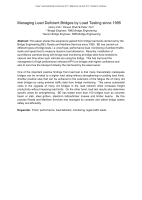Bridges

- Publication no: ABC2017-055-17
- Published: 21 April 2017
- PDF (free) Download
This paper shares the experience gained from bridge load tests carried out by the Bridge Engineering (BE), Roads and Maritime Services since 1995. BE has carried out different types of bridge tests, i.e. proof load, performance load, monitoring of ambient traffic loads and speed test to measure dynamic load allowance. Recently, installation of surveillance cameras along with bridge load monitoring at bridge sites have enabled to capture real time when such vehicles are using the bridge. This has improved the management of high performance vehicles (HPV) on bridges with higher confidence and also to convince the transport industry the risk faced by the asset owner.
One of the important positive findings from load test is that many theoretically inadequate bridges can be re-rated to a higher load rating without strengthening or posting load limits. Another positive step that can be achieved is the extension of the fatigue life of many old steel bridges by using ambient traffic data from bridge monitoring. This saves substantial costs in the upgrade of many old bridges in the road network while increases freight productivity without imposing load limits. On the other hand, load test results also determine specific areas for strengthening. BE has tested more than 100 bridges such as concrete beam or slab, steel girders, steel/iron lattice/timber trusses and timber beams. By this process Roads and Maritime Services has managed its complex and oldest bridge assets safely and efficiently.
